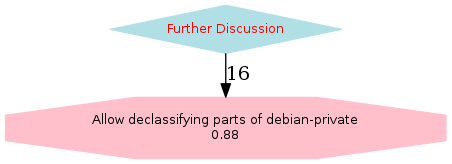General Resolution: Declassifying debian-private
Time Line
| Proposal and amendment | 2016-07-07 | |
|---|---|---|
| Discussion Period: | 2016-07-19 | |
| Voting Period: | 2016-08-07 00:00:00 UTC | 2016-08-20 23:59:59 UTC |
Proposer
Nicolas Dandrimont [[email protected]] [text of proposal] [acceptance of new text] [call for votes]
Choice 1: Allow declassifying parts of debian-private
Title: Declassifying parts of -private of historical interest- The 2005 General Resolution titled "Declassification of debian-private list archives" is repealed.
- Debian listmasters and/or other individuals delegated by the DPL to do so are authorized to declassify excerpts of -private of historical interest by any process which at minimum provides sufficient time and opportunity for Debian Developers to object by GR prior to declassification.
- In keeping with paragraph 3 of the Debian Social Contract, Debian Developers are strongly encouraged to use the debian-private mailing list only for discussions that should not be disclosed.
Quorum
With the current list of voting developers, we have:
Current Developer Count = 1040
Q ( sqrt(#devel) / 2 ) = 16.1245154965971
K min(5, Q ) = 5
Quorum (3 x Q ) = 48.3735464897913
Quorum
- Option1 Reached quorum: 118 > 48.3735464897913
Data and Statistics
For this GR, like always, statistics will be gathered about ballots received and acknowledgements sent periodically during the voting period. Additionally, the list of voters will be recorded. Also, the tally sheet will also be made available to be viewed.
Majority Requirement
The proposal needs a simple majority
Majority
- Dropping Option1 because of Majority. 0.881 (118/134) <= 1
Outcome
In the graph above, any pink colored nodes imply that the option did not pass majority, the Blue is the winner. The Octagon is used for the options that did not beat the default.
- Option 1 "Allow declassifying parts of debian-private"
- Option 2 "Further Discussion"
In the following table, tally[row x][col y] represents the votes that option x received over option y. A more detailed explanation of the beat matrix may help in understanding the table. For understanding the Condorcet method, the Wikipedia entry is fairly informative.
| Option | ||
|---|---|---|
| 1 | 2 | |
| Option 1 | 118 | |
| Option 2 | 134 | |
Looking at row 2, column 1, Further Discussion
received 134 votes over Allow declassifying parts of debian-private
Looking at row 1, column 2, Allow declassifying parts of debian-private
received 118 votes over Further Discussion.
Pair-wise defeats
The Schwartz Set contains
- Option 2 "Further Discussion"
The winners
- Option 2 "Further Discussion"
Debian uses the Condorcet method for voting.
Simplistically, plain Condorcets method
can be stated like so :
Consider all possible two-way races between candidates.
The Condorcet winner, if there is one, is the one
candidate who can beat each other candidate in a two-way
race with that candidate.
The problem is that in complex elections, there may well
be a circular relationship in which A beats B, B beats C,
and C beats A. Most of the variations on Condorcet use
various means of resolving the tie. See
Cloneproof Schwartz Sequential Dropping
for details. Debian's variation is spelled out in the
constitution,
specifically, A.6.
Debian Project Secretary

